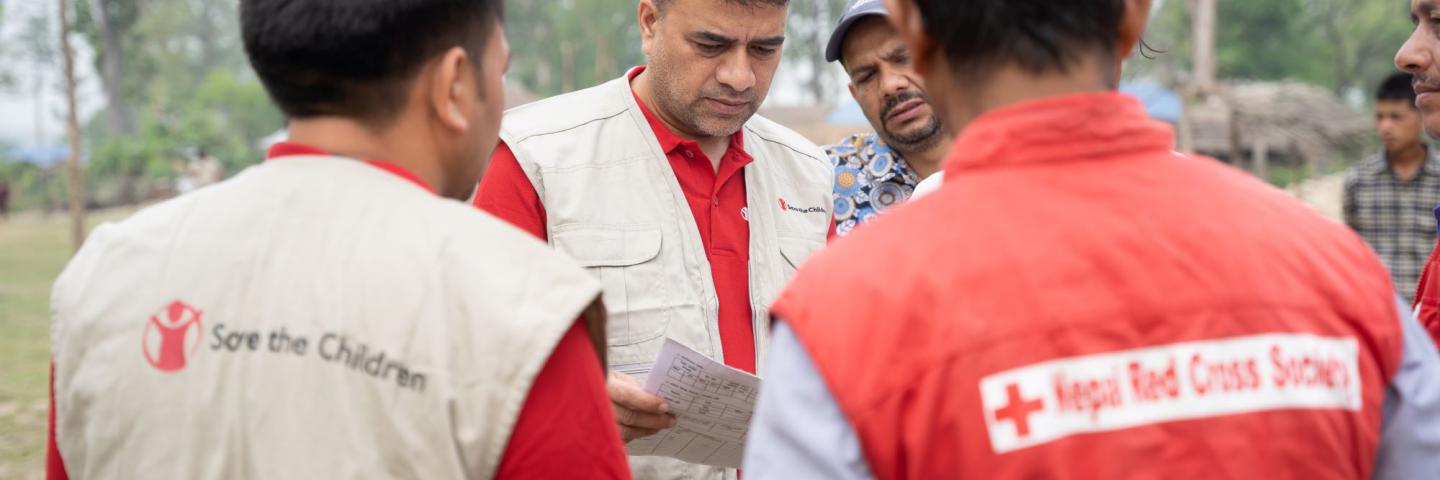Save the Children (SC) works in all phases of disaster management, actively involved in humanitarian responses, recovery, preparedness, and disaster risk reduction. In doing so, we strive to ensure that children's immediate needs are met during emergency situations, providing access to education and protection services, and helping them regain a sense of normalcy. We address these needs by enabling a safe physical environment and developing the capacities of local authorities, child clubs, schools, communities, and partners to efficiently manage and minimize the effects of disasters. In the case of national-level disasters, SC supports program areas that align with the country's Emergency Preparedness Plan and Save the Children's Humanitarian Strategy, closely coordinating with the government.
Save the Children acts as a catalyst for child-centered humanitarian responses, supplementing and complementing the efforts of the government and other stakeholders in all 77 districts of the country, as required.
In Nepal, Save the Children has enhanced humanitarian preparedness and response capacity to deliver timely, quality interventions, rapidly meeting the immediate basic needs of people affected by disasters. We also have the capacity to reach the most deprived and marginalized communities, including women, girls, children, people living with disability during emergency responses. Save the Children's humanitarian response program is gender and inclusion sensitive.
SC prepositions kits to address the needs of children and persons with disabilities (CWD) during emergencies. It holds the capacity to support the government's efforts to respond to 50,000 adults and children in case of a mega emergency within 48-72 hours, with lifesaving kits prepositioned in seven strategically located warehouses across the country. The intent of our preparedness and response work is to provide immediate life-saving assistance to disaster-affected populations, with a special focus on children.
Save the Children provides support to ensure effective preparedness systems are in place, minimizing the negative effects of disasters on children and their families. We advocate to influence and support key humanitarian actors to prioritize children's well-being in emergencies. One of the key priorities is integrating and mainstreaming Disaster Risk Reduction (DRR) and Climate Change Adaptation (CCA) interventions into regular development programs. Save the Children's humanitarian approach incorporates Anticipatory Action (AA) to provide critical support to at-risk communities before disasters or their full impacts occur. By utilizing forecasts and early warnings of imminent shocks or stress, our aim is to reduce the impact of disasters and improve post-disaster responses.
We work closely with local governments to integrate disaster risk reduction (DRR) into their development processes through the Local Disaster and Climate Resilience Plan (LDCRP). Our focus is on creating an inclusive Disaster Risk Management (DRM) system, ensuring marginalized groups like women, children, persons with disabilities, senior citizens, and minority communities have access, representation, and meaningful participation in the planning process. We also coordinate with federal and provincial governments to synergize efforts and design an Early Action Protocol for a more effective disaster response.
Save the Children has over 120 staff and partner NGO personnel trained in Emergency Response, ready for deployment in case of a mega emergency in the country. We have also built and strengthened our humanitarian partnerships with many in-country donors and are recognized as one of the leading humanitarian responders in the country.

Future Direction
Save the Children is committed to becoming the leading humanitarian response agency for children and their families, delivering quality and timely responses to support the government's efforts. Anticipating more emergencies, including ones like COVID-19, Save the Children is always prepared and ready to respond to any emergency in any part of the country with life-saving materials for affected families. With children at the center of our actions, we are committed to enhancing the capacity of the government, partner agencies, and our staff, collaborating in responding to emergencies, relieving the impact of crises, and supporting the recovery process.